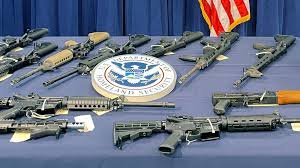
The phrase guns international refers to the global market and trade surrounding firearms, encompassing manufacturing, regulation, cultural perspectives, and legal frameworks. With the increasing interconnectedness of economies and societies, understanding the implications of guns international is vital for various stakeholders, from policymakers to consumers. This article delves into the history, legal aspects, economic factors, cultural attitudes, technological advancements, challenges, and future trends in the guns international landscape.
Table of Contents
Historical Overview of Guns International
The history of firearms is rich and complex, with significant milestones that have shaped the guns international market.
- Early Developments: The origins of firearms can be traced back to the invention of gunpowder in China, leading to the creation of primitive guns. As these innovations spread, they laid the groundwork for modern weaponry.
- Colonial Expansion: The proliferation of firearms coincided with European colonialism, where nations like Britain, Spain, and France exported guns to various parts of the world, establishing a global market.
- World Wars Impact: The two World Wars dramatically increased the production and technological sophistication of firearms. Countries ramped up their military capabilities, resulting in significant advancements in weapon design.
- Cold War Era: The geopolitical tensions of the Cold War further fueled the guns international market, as superpowers supplied arms to allies and proxy groups, leading to widespread proliferation.
- Modern Landscape: Today, the guns international market is characterized by diverse manufacturers, regulations, and consumer preferences, reflecting the complexities of global trade.
Legal Frameworks Governing Guns International
Legal regulations surrounding firearms vary significantly across countries, impacting the guns international market in profound ways.
- United States: The Second Amendment provides a constitutional right to bear arms, resulting in a robust gun culture and a permissive regulatory environment. However, states implement their own laws, leading to variations in gun ownership regulations.
- European Union: In contrast, the EU has established stringent regulations aimed at ensuring public safety. Member states are required to comply with directives that regulate the sale and possession of firearms, leading to a more controlled guns international market.
- Asia: Countries like Japan and South Korea maintain extremely strict gun laws. The guns international market in these regions is limited, focusing mainly on hunting and sporting firearms.
- Developing Regions: In many African and Latin American countries, issues related to gun violence and illegal arms trafficking are prevalent. Efforts to regulate the guns international market often emphasize combating these challenges.
- International Treaties: Treaties such as the Arms Trade Treaty (ATT) aim to regulate the international trade of conventional arms, including firearms. These agreements promote responsible trade practices and seek to minimize the impact of armed conflict.
Economic Aspects of Guns International

The guns international market is a significant contributor to the global economy, encompassing various sectors and activities.
- Manufacturing: Major firearms manufacturers like Smith & Wesson and Glock lead the guns international market, investing heavily in innovation and production capabilities.
- Trade Dynamics: The import and export of firearms create a complex web of international trade relationships. Countries with established manufacturing bases often export to nations with lower production capacities.
- Retail Channels: Firearms are sold through various platforms, including brick-and-mortar stores, online marketplaces, and gun shows. The rise of e-commerce has transformed how consumers engage with the guns international market.
- Economic Influences: Changes in legislation can have significant economic repercussions. For instance, stricter gun control measures may decrease sales in certain regions, while relaxed regulations could spur demand.
- Market Trends: The guns international market is experiencing trends such as an increase in personal defense firearms, the popularity of hunting, and advancements in technology driving new product development.
Cultural Attitudes Toward Guns Internationally
Cultural perspectives on firearms play a crucial role in shaping the guns international market.
- United States: Gun ownership is often viewed as a fundamental right in the U.S., deeply ingrained in its culture. This perspective fuels high demand for firearms and shapes the guns international landscape.
- European Views: In many European countries, firearms are seen as potential threats to public safety. This cautious approach influences legislation and consumer behavior in the guns international market.
- Asian Perspectives: Countries with restrictive gun laws often view firearms as associated with crime. This has led to a smaller guns international market in regions like Asia, focused mainly on hunting.
- Media Influence: Portrayals of firearms in media can significantly affect public perception. Positive depictions may enhance the appeal of gun ownership, while negative representations can lead to calls for tighter regulations.
- Global Cultural Exchange: As cultures interact, attitudes toward firearms are evolving. The guns international market must adapt to these shifts, reflecting changing consumer preferences and societal norms.
Technological Innovations in Guns International
Technological advancements are reshaping the guns international market, influencing various facets of production and consumer experience.
- Manufacturing Advances: Techniques like 3D printing are beginning to play a role in the production of firearms. This innovation could democratize gun manufacturing and alter traditional guns international supply chains.
- Smart Gun Technology: The development of smart guns incorporates safety features such as biometric locks, enhancing user security. This innovation aims to address concerns about accidental discharges and unauthorized access.
- Digital Commerce: The rise of online platforms for buying and selling firearms is transforming the guns international market. E-commerce provides consumers with wider choices and competitive pricing.
- Tracking Systems: Advanced tracking technologies are being used to monitor firearm sales and ownership. These systems can improve compliance with regulations and enhance the overall safety of the guns international market.
- Safety Innovations: Manufacturers are increasingly focused on integrating safety features into firearms. This trend reflects changing consumer expectations and regulatory pressures within the guns international market.
Challenges Facing Guns International
The guns international market faces numerous challenges that impact its growth and stability.
- Illegal Trade: The illicit arms trade presents a significant threat to global security, with efforts to combat it requiring international cooperation and robust legal frameworks.
- Gun Violence: High rates of gun violence in various regions prompt public demands for stricter regulations, influencing the dynamics of the guns international market.
- Economic Factors: Economic downturns can impact consumer spending on firearms, requiring businesses to adapt to changing market conditions in the guns international sector.
- Regulatory Compliance: Navigating the intricate web of international regulations can be challenging for manufacturers and distributors, necessitating a thorough understanding of local laws.
- Public Perception: Stigmas associated with firearms can affect consumer behavior and market dynamics. Engaging with the public to foster informed discussions about gun ownership is crucial.
Future Trends in Guns International

The guns international market is poised for significant transformation, influenced by various emerging trends.
- Sustainability Practices: As global awareness of environmental issues rises, the firearms industry may need to adopt sustainable manufacturing and distribution practices.
- Regulatory Changes: Ongoing debates about gun control will likely lead to evolving regulations, impacting the guns international market in significant ways.
- Emerging Consumer Markets: The demand for firearms is expected to grow in emerging markets, driven by increasing concerns about personal security and shifts in cultural attitudes.
- Technological Integration: The continued integration of technology into firearms will drive product innovation, reshaping consumer expectations in the guns international market.
- International Collaboration: Collaborative efforts among nations will be crucial in addressing challenges such as illegal arms trade and gun violence, ensuring a more responsible guns international market.
Also read 716 Area Code Exploring Its History and Significance
Conclusion
The guns international market is a multifaceted and dynamic sector influenced by historical, cultural, legal, and technological factors. As this landscape continues to evolve, understanding the complexities surrounding firearms becomes essential for stakeholders. The ongoing developments within the guns international arena underscore the importance of responsible practices, informed consumer choices, and collaborative efforts to foster a safer and more sustainable future for firearms worldwide. The interplay of these elements will shape the trajectory of the guns international market for years to come, necessitating ongoing dialogue and adaptation in response to emerging challenges and opportunities.




